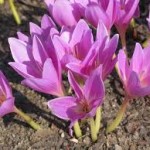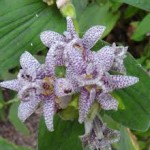There is nothing more frustrating than growing a plant all season only to have it eaten off by the wildlife before it blooms. Unless maybe it is the chipmunks and squirrels consuming all of those expensive bulbs that you put in with great hopes of enjoying their spring beauty. Have you ever planted a nice selection of annuals only to have a groundhog eat them down to the ground by the next day? What is the solution to the problem of voracious wildlife?
There are number of things a gardener can do. There are physical barriers, deterrent sprays or trying to remove the problem animals. It might just be more productive to approach the problem from the other direction. Plant vegetation that is not edible.
There are plants that animals will not touch. The reason, in most cases, is that the plant is toxic. This is not a foolproof method, as a plant may not be toxic in all of its parts or it may be less toxic at certain times of the year. Some animals are immune to the toxic substances in specific plants and susceptibility can vary by species as well as by individual animals. Hostas are said to be poisonous to dogs but deer eat them with impunity. If an animal is hungry enough and the plant is not lethally toxic, it may still consume it. This is true of rhododendrons, which contain grayanotoxin, a poisonous substance that causes severe gastric upset. Still deer will frequently eat off all the leaves and buds that they can reach in the winter. They will stand on their hind legs to eat leaves that, by all accounts, give them a severe stomachache.
While we cannot in good conscience suggest that you plant a garden full of poisonous plants if you have children or domestic animals that tend to nibble, is certainly an option if there no critters, human or otherwise, that might be endangered. If you have a large area under cultivation you may consider planting some of these plants further from the house where it is difficult to protect plants from marauders and where they are less accessible to domestic animals or children.
Bulbs
Daffodils (Narcissus spp.) All parts of the daffodil are poisonous. We guarantee that nothing will touch these.
Autumn Crocus (Colchicum autumnale) Again all parts of the plant are poisonous. The flowers and leaves do not appear at the same
time and neither are eaten in my garden.
Caladium (Caladium spp.) All parts of the plant are poisonous. Must be lifted in the fall.
Hyacinth (Hyacinthus orientalis) Only the bulbs are poisonous. The flowers and leaves are often eaten.
Lily of the valley (Convallaria majus) Leaves and flowers are poisonous but while this one is listed as a bulb it spread through rhizomes.
Star of Bethlehem (Ornithogalum umbellatum) Entire plant
Perennials
Foxglove (Digitalis purpurea) The original source of digitalis. The poisonous parts are the leaves and flowers. Nothing touches this plant.
Monkshood (Aconitum napellus) Roots, foliage and seeds. This is one of the most deadly plants in the garden.
Bloodroot (Sanguinaria Canadensis) Entire plant especially the stem and roots.
Buttercup (Ranunculus spp.) Entire plant especially the leaves. There are 250 species of buttercups; their status as poisonous plants may vary.
Christmas rose (Helebore spp.) Rootstock and leaves
Delphinium (Delphinium spp.) Entire plant especially the sprouts.
German Iris (Iris germanica) Leaves and roots. I’ve had iris shoots eaten in the spring but they are untouched the rest of the year.
Snow on the mountain (Aegopodium podagraria) Sap. The variegated form is pretty enough but it is invasive.
Bleeding heart (Dicentra sppectabilis) Leaves and roots. This one is safe from even groundhogs.
Gas plant (Dictamnus albus) All parts. Avoid contact with skin.
Lupine (Lupinus spp.) All parts but only in fairly large quantities. I’ve had animals nibble on lupines.
Poppy (Papaver spp.) All parts especially unripe seed.
Garden mum (Chrysanthemum spp.) Severe skin irritant. It is unclear whether this bothers animals but it seems reasonable to assume it would irritate their mouths. At any rate none in my garden have ever been touched.
Columbine (Aquilegia spp) Contains aconitum but apparently in small quantities. Nothing seems to bother it.
Coneflower, Black-eyed Susan (Rudbeckia spp.) All parts. Large amounts must be ingested.
Cardinal flower (Lobelia cardinalis) All parts.
Goldenrod (Solidago spp.) All parts. Contains resinous compounds
Toad Lily (Tricyrtis hirta) All parts of the plant are poisonous. Great shade plant!
Vines and Shrubs
Rose of Sharon (Hibiscus syriacus) Flowers and leaves. Nothing seems to bother it.
Yew (Taxus spp) Contains highly toxic taxine alkaloids in foliage.
Mountain Laurel (Kalmia latifolia) Leaves, twigs, flowers, and pollen. Contains andromedotoxins
Hydrangea Shrubs (Hydrangea macrophylla)) The entire plant, especially the flower buds. Contains cyanide.
Burning Bush (Euonymus spp) All parts
Azaleas ( Azalea spp) Leaves and flowers
Rhododendrons ( Rhododendron spp) Leaves and flowers
Boxwood Shrubs (Buxus spp) Entire plant especially leaves
Privet Bushes (Ligustrum spp) Leaves and berries
Wisteria (Wisteria sinensis) All parts except possibly the flowers
American bittersweet (Celastrus scandens) Questionable but contains saponins that irritate the mouth.
English Ivy (Hedera helix) Entire plant especially leaves, berries
Elderberry (Sambucus spp) Leaves, bark, roots, buds
Clematis (Clematis spp) Leaves contain essential oils that are extremely irritating to the digestive tract and mucous membranes.
Annuals
Larkspur (Consolida Orientalis) Plants are poisonous when young.
Morning glory (Ipomoea) Seeds and roots
Castor bean (Ricinus communis) All parts especially the seeds. Intestinal upsets with consumption and rashes and burning on contact. Highly toxic.
Flowering tobacco (Nicotiana alata) All parts. The poison is nicotine.
There are very few annuals that are toxic to animals or humans. The unpleasantly scented ones such as marigolds are less commonly eaten by wildlife.
I’ve grown about 80% of these plants and very few of them are eaten by deer, groundhogs or rabbits. The three that I find that are bothered are rhododendrons, iris and lupines.
Rhododendrons are definitely deer food in the winter. They can do considerable damage to them eating off leaves and buds. Not only does the deer damage look unsightly for most of the summer but these sections fail to bloom
Iris shoots are eaten in the spring by either deer or groundhogs. I’ve never been sure which caused the damage. My suspicions lie with the deer as they usually get the woods hyacinths and the emerging daylilies at the same time. It doesn’t really harm the iris. It usually happens so early in the season that they have sufficient time to recover. Iris may be one of the plants that is only becomes toxic as it grows older.
Lupines will occasionally have a leaf or two removed. Because of the minimal grazing I think it is probably rabbit damage. I’ve grown 27 plants on this list and only 3 have ever sustained animal damage. Those are fairly good odds


Are you sure clematis is poisonous/irritating? I ask because I’ve been having problems with mine this year. I kept going outside and finding it torn up. I actually thought that children were destroying it (picking pieces off of it and throwing them on the ground), but it struck me as strange because it is quite close to my house for that. But just now — literally just now — I heard rustling in it, looked out to catch the culprit in the act and found a squirrel eating it. EATING IT. I have never wanted to eat a squirrel myself so bad in my life. Squirrels have eaten my apples, all my produce and numerous other plants (including daffodil plants — apparently my squirrels either have iron stomachs or death wishes).
I’m about to uproot everything and plant cyanide, erm, hydrangea everywhere. Maybe that will take care of them.
I’ve seen squirrels pull up plants just for the fun of it. I just found a newly planted 4 o’clock uprooted. Sometimes the bite off the tops and let them lay. My mother-in-law used to make squirrel in tomato sauce. You might try it.
If animals get hungry enough they will eat things that don’t outright kill them but give them a case of indigestion. Deer and rhododendron is an example. We did have a couple of cases where animals ate monk’s hood or aconite and died. The groundhog was a sure kill as his body was found in proximity. The deer a suspected kill but as he was found in a random location there was no proof. You might just have too many squirrels. How about a couple of cats?
I’m late to the game here for comments – but here in Virginia we have a target rich environment with the squirrels – so much that they are completely out of control. They destroy plants, gardens and have invaded our attic – destroying insulation and everything in their path. I consider them rodents and treat them as such. We have several hundred acres of oak trees next door and thinning the herd here doesn’t slow them down in the slightest – but we do keep them at bay. Cats don’t do much for deterring squirrels.